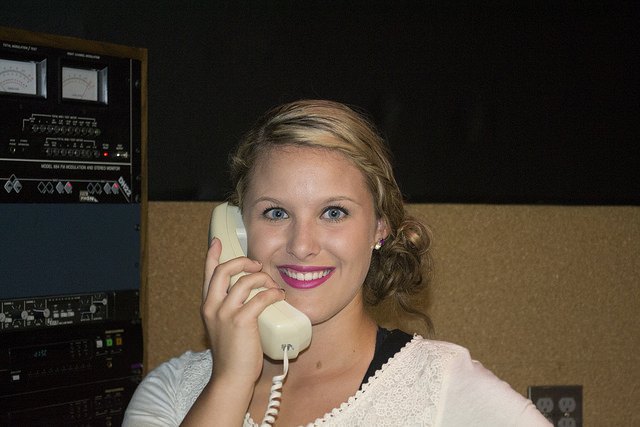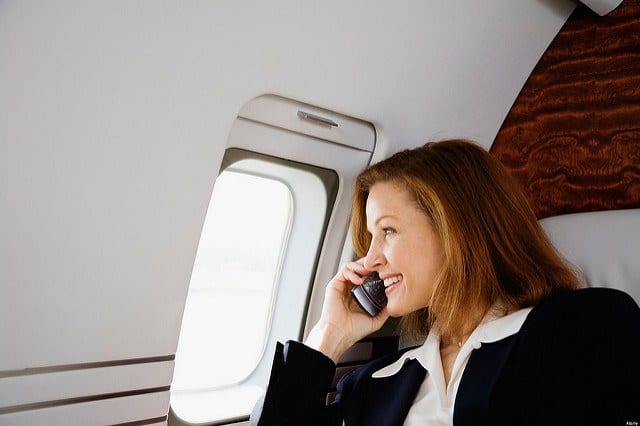Where are your manners? In business and in distant personal affairs, it’s best to always put your best foot forward. This is important in communicating with others in general, but some may feel that phone etiquette and other methods of communicating are a little less intuitive. No worries, we already have a posts about email etiquette, business texting etiquette and etiquette for asking and answering questions. But that still leaves room for some very important lessons to learn about our personal favorite method of communication: the phone! Below are some examples of phone etiquette and best practices that you may not be aware of.
When is a Phone Call the Best Way to Communicate?
The first place to start when discussing phone etiquette is determining if you should be on the phone with someone to begin with.

image via www.rentvine.com
There are so many ways to communicate a message. You can send an email, a text, a DM or a letter. The message can be spoken word, written word, an emoji, or a thumbs up. You can have a phone conversation or you can leave a message with a machine. All of forms of communication are valuable.
Sometimes the message you’re sending is better off done through a specific medium. Text messaging has gotten more popular over the years as smart phones flooded the market. But, a good ol’ phone call is still often a much better way of having a quick, informative conversation that is direct and to the point.
When should I call instead of email or text?
According to Hubspot, there are six different times in which a phone call would certainly be the best medium to get your message across. These times are when you want to apologize, anticipate many questions, have to explain something complicated, have taken too long to respond to previous emails, want to discuss personal information, or when it’s something more URGENT than flagging an email as urgent can express.

image via flickr
You should save bad news for a phone call or in-person meeting. Text, email, and various other forms of communication would be considered insensitive mediums to use.
Returning calls
When someone attempts to reach you through one method of communication, it’s best practice to return with the same method. So if someone leaves you a message on your voicemail, don’t send them an email. This is an instance in which a phone call is merited.
Phone Etiquette: Making a Call
You’re not always on the receiving end of a phone call. There are times when you’re making a call. If this is the case, there a few other phone etiquette items we should touch on.

image via flickr
Dial carefully
Double check to ensure that you’re dialing the correct digits. Calling the wrong number wastes your time and someone else’s. In the case that you do dial a wrong number and someone answers, apologize and tell them that you’ve dialed the wrong number. Don’t hang up on them with no explanation.
Start with some preparation
Have a good idea about what you need to discuss and the questions you intend to ask. Jot down a list to be sure that you don’t miss any major points and need to call back.
If you like it, you shoulda put [more] ring[s] on it
Allow the phone to ring plenty before hanging up. You should allow for many rings so that they may get to the phone or their voicemail can take the call.
Ask if now is a good time to speak
Be considerate of the other person’s time.
Add a bit of small talk when talking business
It isn’t deemed appropriate in American business culture to immediately go into asking someone a favor or for information. This is in contrast to countries like Japan, where they see small talk as a rude distraction. They may prefer to get to the point, but here it is rude to go straight into an ask. Instead, we have small talk.

image via wocintechchat.com
Mastering small talk is all about making the other person the center of focus rather than yourself. Asking questions about their family, a common hobby, or current events is appropriate when making conversation. Keep it light and positive. Don’t discuss gossip, controversial issues, or overly-personal questions.
Phone Etiquette: Before You Answer
How many times should the phone ring before it is answered?
There should be no more than three rings before the phone is answered. A caller could begin to question whether or not they dialed the correct number, give into phone anxiety, or assume you’re not open for business if there are too many rings.
Are you ready?
Empty your mouth before picking up the receiver. You shouldn’t be eating or drinking anything or chewing gum. Swallow any excess saliva and clear your throat if need be.
Greetings
Who are you?
Identify yourself at the beginning of the call. If you’re representing your business, say your name and the name of your business as you greet the caller. For example, “Apollo Answering Service, this is Kelsie,
During the Conversation
Use your manners!
When learning How to be a Good Receptionist, you learn how far good manners can get you. But manners aren’t for only those who are in the telephone answering business! I’m sure you’re already familiar with common courteous phrases, but here’s a refresher:
Phrases to Say Frequently
- Please
- Thank you
- You’re welcome
- My pleasure
- Good morning
- Good afternoon
- Have a great day
- Have a great weekend
- The caller’s name
Don’t forget to focus
Don’t try to multitask during a call. Your inattention could be noticed. But that would be the least of your worries. If you’re not giving a phone call your utmost attention, you could forget valuable information that was discussed, forget to mention something that was important, or leave the other person feeling disrespected.
Don’t get muffled

image via flickr
Keep the phone at least two fingers’ distance from the receiver for best quality of sound. Otherwise the caller will hear a muffled, breathy person on the other end of the line.
Speak clearly
Don’t talk too fast or too slow. Be sure to speak loud enough so that the person on the other end of the line can hear you clearly, but be sure to not sound as if you may be shouting at the person.
Think about your tone
Much of face-to face communication is in facial expressions and body language. A telephone conversation, unfortunately, does not allow for that type of information to be shared person-to-person. Because you can’t see one another! All that can be shared is through the words that you say and the tone of voice that you use.
Never interrupt
You should always allow the caller to tell you the whole story. Listen intently, even if you’ve been briefed on what the caller needs. You may get more details than you were given before or you may not.
Remember, this is a dialog
Allow the person on the other end of the line room to give their input, ask questions, and respond to what you’re saying. Keep in mind that this doesn’t have to be the last conversation you have with this person. You don ‘t have to get out every thought on the subject matter
Listen Actively
It’s not enough to catch a couple of phrases when a customer is venting yo you about and issue that they have been experiencing with the product or service that you represent. You’ll have to give them your full attention and be sure that the only one repeating anything is you: confirming spellings, numbers, and that you understand where their issues lie.
Use the Caller’s Name
Remember back when we wrote that exhaustive email etiquette post? We said it then and we’ll say it again: it’s important to use someone’s first name when addressing them. When you use someone’s name, whether it is on the phone or through email, you make the interaction for personal and more comfortable for the other person.
Smile When You Speak
This might sound a little silly. Believe it or not, this is something that may help you a lot when learning how to deal with angry customers. In fact, when learning how to be a good receptionist, this is something they learn first! When you smile, the chemicals go off in your brain that make you feel happier and more relaxed. It will take the edge off, even if it may be difficult at first.
Use the hold button
When diverting your attention from the phone conversation to anything else, utilize the hold button rather than muffling your voice with your hand over the receiver. But don’t place someone on hold without asking their permission first. Ask if you may place them on hold, wait for an answer, thank them, then press hold.
Keep hold times to a minimum
Don’t let your caller get lost. Say you’ve put the caller on hold in order to have them connect with someone else in the building, or you’re transferring their call to another department. It’s your responsibility to make sure that they’re connected with that person. Therefore, if you see the line is still active and that it has not been attended to, you should follow up. First with the caller, then with the person they are trying to reach. Call wait time should be brief.
Don’t use slang
Slang can be divisive and confusing. Good phone etiquette calls for saying the exact words that you mean.
What about phone etiquette with an angry customer?
Don’t tell someone to calm down! This nearly always has the opposite effect. The trick is to listen with empathy, react with kindness, give the caller options, and to go the extra mile. Dealing with unhappy people is tricky, and that’s why we wrote an entire post on how to deal with angry customers.
Ending a Call
Don’t ruin a good thing by ending on an off note. Always ask the caller if there is any other way that you can be of assistance. If yes, further assist the caller. If no, then thank them for their call, their patronage, or their interest. Then wish them a pleasant day.
Often, it is considered in the best taste to allow the caller to be the one to end the call first. Know when to follow this advice or take notice when conversation is lagging and it is best to end the call.
Cell Phone Etiquette
This is an important aspect of telephone use that we wish everyone would take into consideration: cell phone etiquette. It may be convenient to have the opportunity to take a call wherever you are, but that doesn’t mean you always should. Answering your phone in many public spaces is rude. It contributes to noise pollution. Often in the midst of the phone conversation, the person on the phone is unaware of the people round them and the way that their actions and loud talking are affecting others.
Times in which you should have your cell phone or smartphone turned off or silenced are in movies, in the library or a restaurant, waiting rooms, churches, weddings, funerals, and conventions, for example.
When you’re in public spaces like on or waiting for public transit, waiting in line at a store, at a shopping mall, a restaurant or a hospital, you should be sure that when you answer a call, you keep it very brief and quiet.
When you’re checking out at a retail store, put the phone down. It slows down the transaction and is disrespectful to the person working at the store.
Are you alone?
It’s rude to take a call when you’re in the presence of someone else. If you must, apologize to the person and explain its necessity prior to taking the call. It’s just as rude, if not more so, to text another person in the presence of others. If you do choose to do so, let the other person know the subject and recipient of the text to reassure that you aren’t talking about them.
When is it okay to use speakerphone?
Nearly never! You’re certainly creating some undue noise pollution if you’re not at home or in a private office. Even if you’re in a private space, speakerphone often creates an echoing effect that is distracting to the person on the other line. You shouldn’t need to place someone on speakerphone if you’re giving them your full attention.
Ask someone first if you may put them on speaker if the conversation is requiring you to do a separate action. Some people would prefer the privacy of no speakerphone used.
Apply this to your small business
A customer or client’s first impression of your business is often what they see online or a phone call to your business. make sure you’re putting your best foot forward by using proper phone etiquette.
Now, try this…
Still not a fan of making or receiving phone calls for your business? Let us handle it. Contact a live call answering service.


